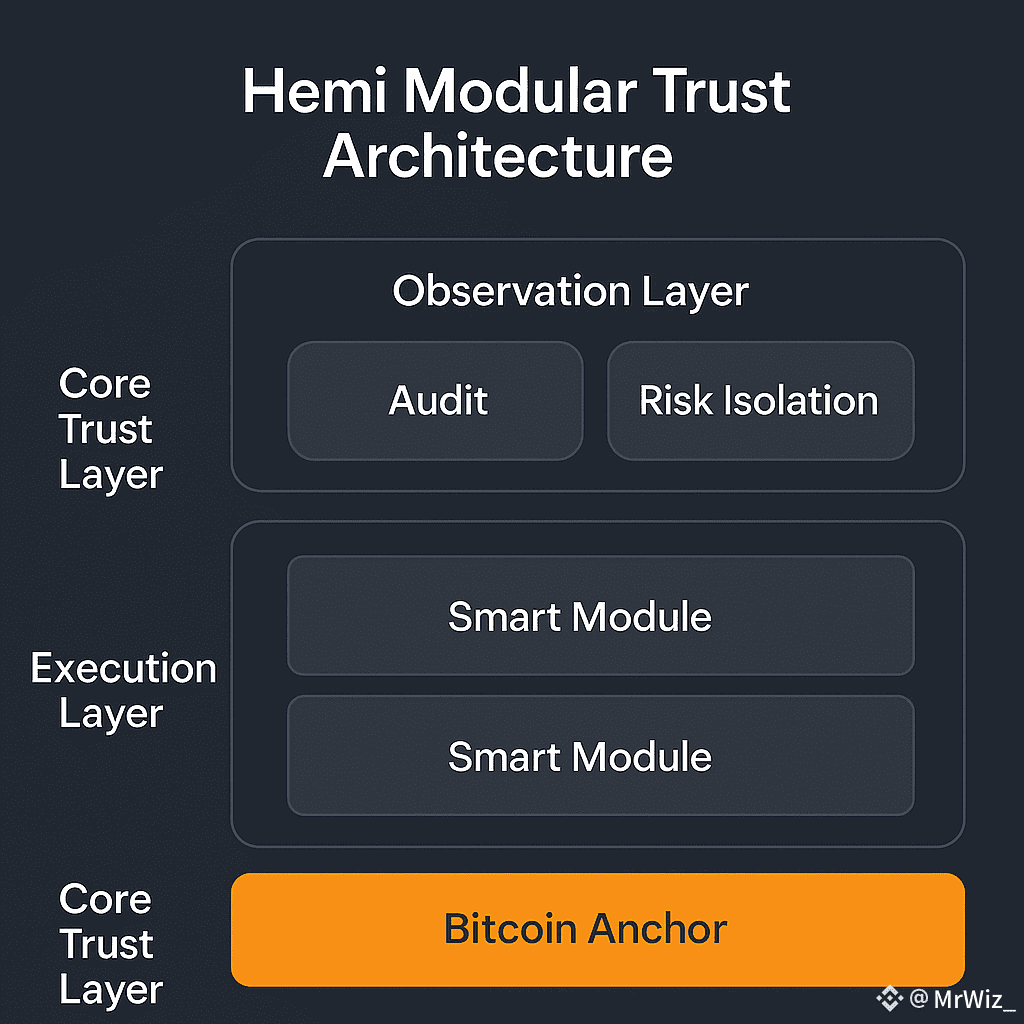In crypto, everyone talks about “security” but few really build it. For most projects, it’s a word on the website. For Hemi, it’s the blueprint. I didn’t understand that until I began studying how its modular design transforms the idea of trust itself from something assumed to something engineered.
When we talk about Bitcoin, we talk about immutability. When we talk about DeFi, we talk about innovation. But when we talk about both together it’s chaos. Immutability hates change; innovation needs it. Hemi sits in the middle of that paradox and says, “What if we don’t have to choose?”
1. Trust as a System, Not a Promise
Most DeFi protocols treat trust like a social contract “we’re transparent, we’re audited, we’re safe.”
But Hemi treats trust as a mechanical system.
Its modular architecture splits responsibilities: one layer for execution, one for data integrity, and one for consensus verification. This separation isn’t just for efficiency it’s for containment. A fault in one layer can’t cascade across the system.
It’s like a submarine with pressure compartments if one fails, the rest still hold. In traditional DeFi, failure is total. In Hemi, failure is local. That’s not just security; that’s resilience by design.
2. The Paradox of Permissionless Security
There’s a tension in crypto between being open and being safe. Permissionless systems invite innovation but also attack.
Hemi’s model feels like the first real answer to that dilemma.
By modularizing execution, it lets builders innovate without compromising the base. You can deploy new financial logic on top, while the trust layer anchored to Bitcoin stays immutable.
That means we can have “permissionless creativity” with “permissioned security.” It’s a balance only modular systems can achieve.
This might sound abstract, but it’s what makes the next generation of financial products viable. Institutional vaults, programmable ETFs, and on-chain treasuries all need this dual reality: freedom and protection.
3. Audits Are Not Enough Self-Healing Systems Are Coming
I’ve reviewed dozens of audit reports across DeFi they all have the same problem: they’re static snapshots in a moving world. Code evolves faster than audits.
Hemi’s architecture proposes something different a dynamic trust layer that adjusts as modules interact.

Because each module is isolated yet observable, security logic can be upgraded or patched without halting the whole chain. It’s closer to an immune system than a firewall.
This is where modular DeFi could change everything: instead of trying to be “unbreakable,” networks like Hemi are becoming self-healing.
4. Institutional Implications From Code Risk to Confidence Layer
If you’ve ever spoken with institutional investors, you know their biggest fear isn’t volatility it’s counterparty risk. In DeFi, that means code risk.
But when a network like Hemi can isolate and quantify risk per module, it changes the entire conversation.
For example:
A BTC liquidity vault can be proven safe even if a DeFi app built on top fails.
Insurance and compliance modules can be independently verified.
Capital allocators can map exposure dynamically, not reactively.
That’s not just blockchain security that’s financial-grade risk modeling.
5. The Human Factor Why Trust Still Needs People
Yet, no architecture, however modular, can eliminate one thing: human trust.
Technology can encode logic, but it can’t encode belief.
What Hemi does best is give humans reason to trust.
When you can see isolation between risk zones, when you know that bridges, validators, and vaults don’t share a single point of failure you behave differently. You engage, you build, you hold.
And that shift in behavior is what security was always supposed to mean not invincibility, but confidence.
6. Final Thought The Blueprint for the Next Era
The future of finance won’t be built on slogans like “trustless” or “decentralized.”
It’ll be built on composable trust systems that can prove, adapt, and recover.
Hemi isn’t the end of that story, but it might be the first chapter that actually makes sense.
Because real security doesn’t come from locking things down it comes from building systems that can breathe.
